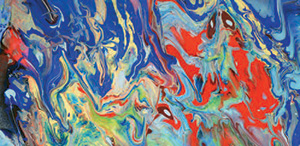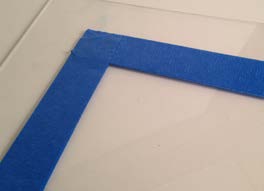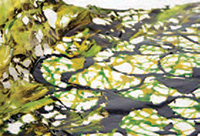£5 OFF Orders over £50 | Use Code 585C
Acrylic Sheets
 This process allows artists to create flexible acrylic sheets of varying size, thickness, sheen, texture and colour. It can be done with a wide variety of Liquitex Mediums and texture gels, in combination with acrylic paint to achieve numerous desired effects. Each medium will impart a different quality to the Acrylic sheet.
This process allows artists to create flexible acrylic sheets of varying size, thickness, sheen, texture and colour. It can be done with a wide variety of Liquitex Mediums and texture gels, in combination with acrylic paint to achieve numerous desired effects. Each medium will impart a different quality to the Acrylic sheet.
Uses
Self Supporting Painting
Acrylic sheets can be used as self-supporting paintings (no canvas or stretcher bars). The finished work might hang directly on wall as a quilt or unstretched canvas. Acrylic may stretch over time in a warm environment.
Collage
Acrylic sheets may be adhered to painting surface and then painted with acrylic paint or mediums.
Sculpture
Acrylic sheets may be adhered to sculptural forms and painted with acrylic paint or mediums.
Directions
Put masking tape on a smooth sheet of glass in the desired shape and size of the acrylic sheet to be created.
Application
Brush
Use a 1/2"-2" wide, soft brush to apply desired Liquitex Acrylic Fluid Medium or acrylic medium/colour mixture. For minimal brush marks, thin with 5-10% Liquitex Flow-Aid Water. (Flow-Aid Water is a mixture of 1 part Flow-Aid and 20 parts water).
Allow to fully dry, depending upon environment, 1-12 hours. While wet, mediums may appear slightly cloudy. When dry, some mediums will be totally clear while others will be translucent to opaque.
Repeat steps #2 & #3 until coating is thick enough so that you can peel it off glass without tearing;
5-12 coats will give you a thickness of 1/16"-1/8".
Coat successive layers in different directions, horizontal then vertical then horizontal, etc.
The thickness of the coating can vary according to your desired effect.
Thin layers between 1/32" to 1/16" may be difficult to handle.
Roller
Use a medium nap roller to apply fluid medium or medium/fluid paint mixture. This method applies the thinnest application of acrylic. Air bubbles may dry in completed sheet.
Trowel
Use a 2" - 6" trowel to apply a 1/8" - 1/4" thick application of Liquitex Gel Medium or medium/Heavy Body paint mixture. This method may result in an uneven application of acrylic.
 Pouring
Pouring
On smooth sheet of glass, tape desired shape with masking tape in 4-5 successive layers so that a ridge or dam is built up around image.

Use a spirit level to insure surface is level. If surface is not level, poured fluid medium will run toward lower edge and dry thicker at that edge.
Use approximately 4 parts Liquitex Pouring Medium combined with 1 part Liquitex Soft Body paint to pour over surface. (Adjust ratio for desired transparency depending on which colours are being used.)
 Paint wet in wet!
Paint wet in wet!Multi-coloured compositions can be created in one sitting if several colours are prepared at a time. Apply the next colour directly after the first pour for spots or crisp concentric circles. (Note: Gravity can be used to manipulate colours when wet by lifting the poured surface and gently tilting to allow the pools of colour to bleed into each other.)
Marbled surfaces can be created using multiple colours applied side by side and then blended using a palette knife or by dragging a fork or pointed tool through the surface.
Allow all methods to dry completely: 48-72 hours.
To remove sheets: use a blade, and score along taped edges to separate sheet. Peel off glass. (If necessary dampen entire surface with a wet sponge to release acrylic sheet from glass surface.)
String Gel
String Gel can be used to create acrylic sheets in a string, open design.

String Gel lends itself to creating long ropey strands of paint when applied by gently dripping it from the end of a brush or knife. This method of application gives the artist much more precise control of the dripped or poured mark, allowing greater detail than would have been previously available by any other means.
After mixing String Gel with either Heavy Body, Soft Body or Ink, pour in desired design onto a smooth sheet of glass.
Once dry, carefully peel off glass.
Adhering to a Support
Select a support that the acrylic sheet is to be adhered to: canvas, wood, Masonite, fabric, etc.
Coat the backside of the acrylic sheet with either Gloss Medium, Gloss Gel Medium or Gloss Heavy Gel Medium, or Gloss Super Heavy Gel Medium.
Quickly position the transfer onto the support and press.
To insure a uniform contact, let transfer dry under weight.
Cover acrylic with palette or wax paper before adding weight to prevent sticking.
If adhering to wood or Masonite, the acrylic sheet may be stapled to support (in addition to or instead of gluing with mediums).
Reccomended Products
Liquitex Gloss Medium & Varnish |
|
Liquitex Matte Medium and Liquitex Matte Gel Medium |
|
Liquitex Iridescent Tinting Medium |
|
Liquitex Gloss Gel Medium, Gloss Heavy Gel Medium and Gloss Super Heavy Gel Medium |
|
Liquitex Texture Gel Mediums |
|











